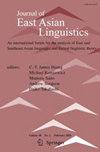On the ordering of elements in ideophonic echo-words versus prosaic dvandva compounds, with special reference to Korean and Japanese
IF 0.5
3区 文学
0 LANGUAGE & LINGUISTICS
引用次数: 0
Abstract
Building on Childs’s (Pragmat Soc 5(3):341–354, 2014) proposal that skewed phonotactic distributions provide a legitimate resource for expressiveness in ideophones, often described as iconic words, this study examines whether there are differences in element ordering between ideophonic echo-words and prosaic dvandva compounds, with special reference to Korean and Japanese. Measured against Cooper and Ross’s (in: Papers from the parasession on functionalism, Chicago Linguistic Society, Chicago, pp 63–111, 1975) claimed-to-be-universal phonological constraints for the ordering of conjoined elements pertaining to element-initial consonants and vowels, the study reveals that both Korean and Japanese data comply with the constraints in general. However, in Korean, echo-words are significantly different from dvandva compounds in their compliance with the consonant constraint while they are not so with the vowel constraint. In reverse, echo-words and dvandva compounds in Japanese show a significant difference in their compliance with the vowel constraint but not with the consonant constraint. The findings provide quantitative evidence for the cross-linguistic applicability of the proposed phonological principles for element ordering and the language-specific phonotactic deviance of ideophones vis-à-vis the matrix language for the preferred ordering patterns.关于表意回声词与表意 dvandva 复词中元素的排序,特别是朝鲜语和日语
Childs (Pragmat Soc 5(3):341-354, 2014)提出,倾斜的语音战术分布为表意音素(通常被描述为标志性词语)的表现力提供了合法的资源,本研究在此基础上,特别参照韩语和日语,考察了表意回声词与平实的dvandva复合词在要素排序上是否存在差异。根据库珀和罗斯(Cooper and Ross's)的研究成果,本研究探讨了表意回声词与平实的 dvandva 复词之间是否存在元素排序差异:该研究显示,韩语和日语的数据总体上符合这些限制条件。然而,在韩语中,回声词与 dvandva 复合词在遵守辅音限制方面有明显不同,而在元音限制方面则不然。相反,在日语中,回声词和 dvandva 复词在遵守元音限制方面有显著差异,但在遵守辅音限制方面则没有。这些发现提供了定量证据,证明了所提出的要素排序语音学原则的跨语言适用性,以及表意音素与母语在首选排序模式上的特定语音战术偏差。
本文章由计算机程序翻译,如有差异,请以英文原文为准。
求助全文
约1分钟内获得全文
求助全文
来源期刊

Journal of East Asian Linguistics
Multiple-
CiteScore
0.90
自引率
0.00%
发文量
13
期刊介绍:
The study of East Asian languages, especially of Chinese, Japanese and Korean, has existed for a long time as a field, as demonstrated by the existence of programs in most institutions of higher learning and research that include these languages as a major component. Speakers of these three languages have shared a great deal of linguistic heritage during the development of their languages through cultural contacts, in addition to possible genealogical linkage. These languages accordingly possess various common features. Another important factor that ties them together as a field is that they have shared a common tradition of linguistic scholarship, a tradition that distinguishes itself from the study of western languages. Against this tradition, much recent work has approached these languages from a broader perspective beyond the area, considering them within contexts of general theoretical research, bringing new lights to old problems in the area and contributing to current issues in linguistic theory. But there continues to be good reason for scholars working in this approach to hold a special interest in each other''s work. Especially with the amount of most recent theoretical work on these languages, the field of theoretical East Asian linguistics has been fast growing. The purpose of the Journal of East Asian Linguistics is to provide a common forum for such scholarly activities, and to foster further growth that will allow the field to benefit more from linguistic theory of today, and enable the languages to play a more important role in shaping linguistic theory of tomorrow.
 求助内容:
求助内容: 应助结果提醒方式:
应助结果提醒方式:


